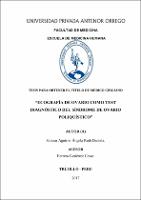Mostrar el registro sencillo del ítem
Ecografía de ovario como test diagnóstico del síndrome de ovario poliquístico
| dc.contributor.advisor | Herrera Gutierrez, Cesar | |
| dc.contributor.author | Salazar Aguirre, Ángela Ruth Daniela | |
| dc.creator | Salazar Aguirre, Ángela Ruth Daniela | |
| dc.date.accessioned | 2018-04-09T14:12:54Z | |
| dc.date.available | 2018-04-09T14:12:54Z | |
| dc.date.issued | 2018 | |
| dc.identifier.uri | https://hdl.handle.net/20.500.12759/3911 | |
| dc.description.abstract | OBJETIVO: Determinar si la ecografía de ovario puede ser usado como test diagnóstico para el diagnóstico del síndrome de ovario poliquístico. METODOLOGIA: Es un estudio observacional, transversal y retrospectivo. Se revisó las historias de pacientes mujeres que acuden a consulta externa del hospital Víctor Lazarte Echegaray con diagnóstico de ovario poliquístico entre enero 2012 a diciembre 2015. Se usaron medidas de tendencia central y dispersión, para el análisis bivariado se usó la prueba T student. RESULTADOS: La muestra estuvo conformada por 220 pacientes. Las edades variaban desde los 11 a 54 años con un promedio en las mujeres con síndrome de ovario poliquístico de 25,64 años y en las que se usaron ecografía de 25,4 años. En cuanto a la paridad el promedio fue de 0,21 en pacientes que se usó la ecografía y de 0,23 en pacientes con diagnóstico de SOP. Respecto a la presencia de criterios diagnósticos de SOP, se evidencio alteración en la ecografía en 157 (73,6%) mujeres, hiperandrogenismo en 117(53.2%) mujeres, y anovulación en 33 (12%) mujeres. En relación a la ecografía, la sensibilidad, especificidad, valor predictivo positivo y negativo fue de 98%, 60%, 75% y 95% respectivamente y la eficiencia de 81%. CONCLUSIONES: La ecografía demostró ser un test diagnóstico con alta sensibilidad, y puede ser usado como test diagnóstico para el tamizaje precoz del síndrome de ovario poliquístico. | es_PE |
| dc.description.abstract | OBJECTIVE: To determine if ovary ultrasound can be used as diagnostic test for the diagnosis of polycystic ovarian syndrome. METHODOLOGY: It is an observational, transversal and retrospective study. We reviewed the histories of female patients who came to the outpatient clinic of Victor Lazarte Echegaray Hospital with a diagnosis of polycystic ovaries between January 2012 and December 2015. Central tendency and dispersion measurements were used for the bivariate analysis using the t student. RESULTS: The sample consisted of 220 women patients. Ages ranged from 11 to 54 years with an average in women with polycystic ovary syndrome of 25.64 years and in which ultrasound of 25.4 years was used. Regarding the diagnostic criteria of PCOS, there was evidence of abnormalities in ultrasound in 157 (73.6%) women, hyperandrogenism in 117 (53.2%) women and anovulation in 33 (12%) women. Regarding parity, the average was 0.21 in patients who used ultrasound and 0.23 in patients diagnosed with PCOS. Regarding ultrasound the sensitivity, specificity, positive and negative predictive value was 98%, 60%, 75% and 95% respectively and the efficiency is 81 %. CONCLUSIONS: Ultrasonography proved to be a diagnostic test with high sensitivity, and can be used as a diagnostic test for the early screening of polycystic ovarian syndrome. KEY WORDS: Polycystic ovarian syndrome, hyperandrogenism, anovulation, ultrasound, parity, sensitivity, diagnostic test. | en_US |
| dc.description.uri | Tesis | es_PE |
| dc.format | application/pdf | es_PE |
| dc.language.iso | spa | es_PE |
| dc.publisher | Universidad Privada Antenor Orrego - UPAO | es_PE |
| dc.relation.ispartofseries | T_MED.HUMA_2283 | |
| dc.rights | info:eu-repo/semantics/openAccess | es_PE |
| dc.source | Universidad Privada Antenor Orrego | es_PE |
| dc.source | Repositorio Institucional - UPAO | es_PE |
| dc.subject | Síndrome de ovario poliquístico | es_PE |
| dc.subject | Hiperandrogenismo | es_PE |
| dc.title | Ecografía de ovario como test diagnóstico del síndrome de ovario poliquístico | es_PE |
| dc.type | info:eu-repo/semantics/bachelorThesis | es_PE |
| thesis.degree.level | Título Profesional | es_PE |
| thesis.degree.grantor | Universidad Privada Antenor Orrego. Facultad de Medicina Humana | es_PE |
| thesis.degree.name | Médico Cirujano | es_PE |
| thesis.degree.discipline | Medicina Humana | es_PE |
Ficheros en el ítem
Este ítem aparece en la(s) siguiente(s) colección(es)
-
Medicina Humana [2739]

